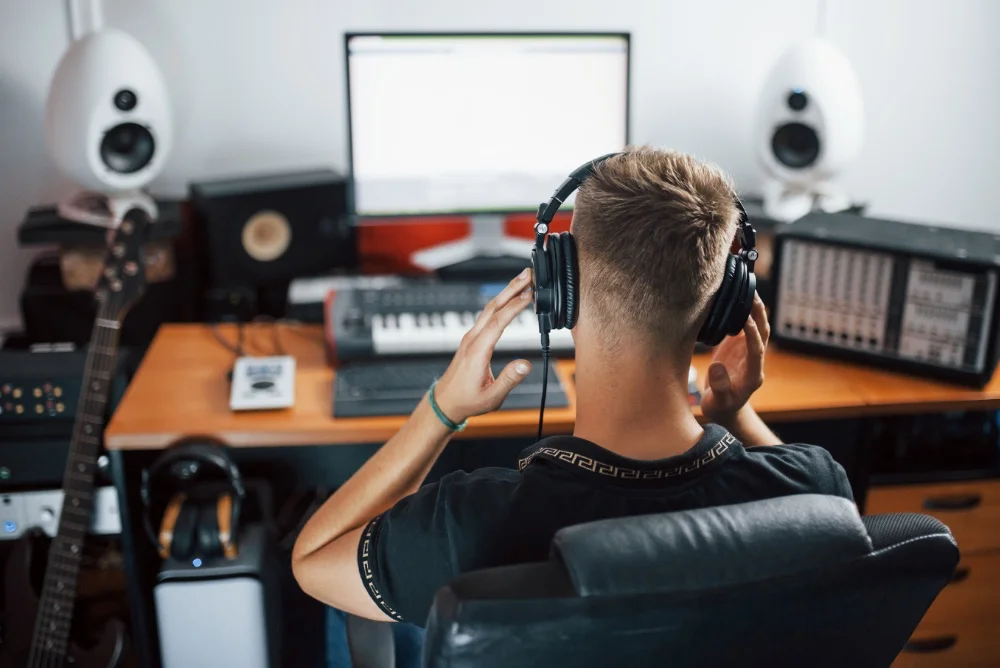An efficient home recording set-up is essential for producers, engineers, and musicians of any level. And luckily, the time has never been better to get into the game. Rapid advances in digital technology over the past decade have made home recording convenient and affordable.
Creatives are making high-quality records in their bedrooms all the time; more often than not, a simple studio arrangement is all it took. The following guide is a basic roadmap for beginners navigating the world of home recording. You’ll probably find that less is definitely more, and a simple setup can yield amazing results!
Invest In A Capable, Quality Computer
The computer is without a doubt the most important part of any home studio. It’s the “brain” of the entire operation; few other components are of much use without it! Whether you prefer a laptop or desktop, Mac or PC is less important than the machine’s specs.
Having a fast processor with plenty of RAM is key number one. Though quad-core processors (i.e. Intel i7) are able to multitask better than dual-cores, a fast dual-core like a 2.9 GHz i5 can handle even very dense projects. It’s advisable to run at least 16 GB of RAM alongside it to ensure your computer’s viability as a music-making machine.
While hard drives are increasingly becoming solid-state, you’ll want it to run at 7200 RPM if yours isn’t. The less time it has to spend “thinking,” the smoother your sessions will perform!
The computer will likely be the biggest investment in your home recording set-up and a place you wouldn’t want to skimp out on. You can move on to software once you’ve settled on a machine.
DAW
A digital audio workstation (DAW) is any software you’ll use to record, arrange, mix & master audio, create MIDI arrangements, or do any other kind of audio editing. Your DAW is where the magic happens, so make sure to pick one and learn it well! The great news is, there are many FREE DAWs available in 2021 – so you don’t need to break the bank to get started!
Whether you choose Pro Tools, Logic Pro X (Mac-only), Digital Performer, Ableton, Cubase, Reaper, Garageband, or any other DAW, is up to you. Each of these DAWs performs the same general tasks in their own unique, proprietary ways. They are all fair options to consider.
Pro Tools is considered the current industry standard and an excellent choice for audio recording and editing. Logic Pro is widely used and has great MIDI capabilities and a deep selection of fantastic virtual instruments. It is Mac-only, however, which may exclude it from some users, though it’s also quite affordable relative to others.
For now, don’t worry about expensive plugins. Every DAW has its own set of stock plugins that will get you up and running!
Audio Interface
The interface is a hardware component that connects microphones or other instruments to your computer. In the simplest sense, it provides I/O for your studio and sends audio signals to your DAW for recording, commonly via USB.
For many home recording set-ups, two inputs are enough. The Focusrite Scarlett 2i2 is popular, featuring two preamps and hybrid XLR/TS inputs for microphones or line-level instruments.
There are numerous great, affordable interface options. What you choose is largely dependent on your I/O needs and personal preference.
Microphones
Beginners should consider investing in one or two “all-around” mics that suit their budget. A large-diaphragm condenser can do just about anything, as can the awesome (and inexpensive!) Shure SM57: a popular workhorse dynamic microphone.
Condenser mics provide a more articulate frequency response, whereas dynamic microphones are more robust and tolerant of high-volume sound sources. If you’re a guitarist, you especially can’t go wrong with the aforementioned SM57 on a speaker cabinet. Conversely, Vocalists may prefer a condenser, like the Røde NT1–an excellent entry-level option.
Consider what you’ll be recording the most and make a decision from there!
Headphones/Monitors
Headphones, headphones, headphones. They’re sometimes of understated importance, but, for many of us, they are the only means of hearing anything we’re doing. Home recording studios seldom have the luxury of really cranking a pair of speaker monitors, particularly when creativity strikes in the wee hours of the night!
Of course, using monitors in a treated room is preferable when it comes to mixing. Get yourself a pair when the time is right! At the very least, headphones are a must for tracking and are passable for mixing. In the early stages of building your home rig, cans are the more affordable and less offensive (noise-wise!) option.
MIDI Controller
If you plan to use virtual instruments in your productions, a MIDI keyboard/controller is indispensable. Manually drawing MIDI data in a DAW is tedious business. Loading up the desired instrument and physically playing it in real-time is a much more familiar/musical experience. Many of them have drum pads, too, allowing you to “play” all of the MIDI information you might be using.
The Bottom Line
Setting up a home recording studio isn’t rocket science; it doesn’t have to be wallet-draining! In fact, you can make music with just a computer and a DAW’s virtual instruments!
Beyond that, a “complete” rig only adds an interface, a microphone or two, a pair of headphones and/or speaker monitors, and a MIDI controller if you’d like one.
The rest is in your hands!




